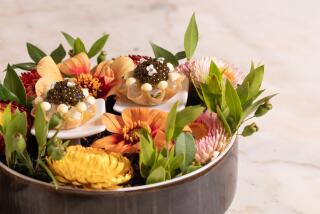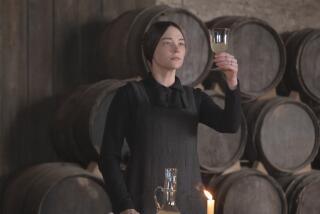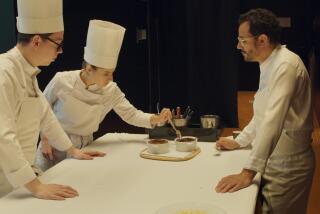Champagne talk with Moët & Chandon’s Benoît Gouez
Benoît Gouez is movie-star handsome, is witty and intelligent, and speaks English as effortlessly as he does his native French - so saying no was not even an option when I was recently invited to be his luncheon guest at Lacroix at the Rittenhouse Hotel in Philadelphia.
Of course, there is also the fact that Gouez is chef de cave at Moët & Chandon, probably the world’s best-known Champagne house and the producer of millions of bottles of bubbly annually. And it was just icing on the gateau that he was bringing with him, in addition to Moët’s standard Imperial, bottles of the just-released 2009 Grand Vintage as well as of the 2002 and 1990 vintages and the MCIII luxury cuvée.
Having a discussion with thoughtful and talented winemakers about philosophies and strategies can be almost as intriguing as tasting their wines, as it provides an insight into what guides their creativity. That is especially the case with Gouez, who was elevated to head winemaker at Moët in 2005.
Here are some notes of what transpired between the amuse-bouche and dessert.
On the 2017 harvest
“It was a very challenging harvest,” Gouez says, “very difficult to work with.” Spring frost reduced the crops, especially of chardonnay, “but pinot from the south was fine. We had to be very selective in picking the grapes, and there was very little wine left for reserves” - the wines put back to age for blending later. However, Moët has plenty of reserves, Gouez says. “Sometimes we get up to almost 50 percent in a blend, which is perhaps too high.”
On balancing harvests
After a vintage that is, say, high in fruitiness and sugar, does he do anything in the vineyard in the subsequent year to try to balance vintages? He is aghast at the thought. “I don’t harvest early to ensure freshness,” Gouez says. “I’m not interested in harvesting green grapes!”
On the current vintages
“The 2008 and 2009 were two great vintages,” Gouez says of what are the current vintage releases from most houses. “The year 2008 was cold and dry, with no rot at harvest. It has a lot of tension and freshness with some austerity. The 2009 had more complete maturity and was very easy to blend into the Moët style - intense with lots of complexity.” Although both are great, Gouez says that the Champenois “globally tend to prefer the ’09 over the ’08.”
On magnum bottles
Sometimes consumers are surprised to see so many magnums (each the equivalent of two standard 750-milliliter bottles) whenever Champagne is being poured. For a variety of reasons, including the better aging potential of the big bottles, Champagne winemakers and collectors prefer magnums and bottle a lot of them. In fact, Gouez so loves magnums that he considers them the standard. When we moved on from the “younger” vintages and a magnum of the 1990 appeared at the table, Gouez said with faux relief, “Now we are though with the half-magnums!”
On Champagne glasses
Generally most Champagne cellarmasters drink Champagne out of white wine glasses to get more aromas, even at the expense of the bubble-up show provided by flutes. When we got to the MCIII, a limited-release wine that was 15 years in the making and costs more than $400 a bottle, Gouez called for red wine glasses. The MCIII is complex in the mouth, and the blending procedure, involving wines aged in wood, steel, and glass, is equally complex. “I use the red glass because this is not just Champagne, but a wine from Champagne. The texture is special. It’s as close as you can get to a Burgundy.”
On pinot meunier
Even though it is grown in large quantities, pinot meunier has always been considered the third Champagne grape in terms of quality. Today, however, some growers are making 100-percent pinot meunier sparklers, and these have generally been well-received. Is this a trend? “I don’t think so,” Gouez says, “but some want to express the diversity we have in Champagne - a good talking point. In general, meunier has less tannins and is more oxidative.”
On the dosage
The dosage is a dollop of liquid sugar added after a bottle is disgorged to dictate its final sweetness. Gouez would like to refine that concept. “My theory is that dosage is just not to sweeten. Rather it helps the wine to recover. Disgorgement [the removal of the sediment that collects at the neck of the upside-down bottle] is a trauma, like surgery. The wine needs two things - medicine (the dosage) and time - in order to recover.”
On bubbles
A quick lesson: “The more a wine ages on its lees,” Gouez says, “the finer the bubbles. Sometimes you may not even notice them. But it’s a fallacy to think that bubbles protect the wine from oxygen. They don’t.”
On ‘coffee’ in Champagne
Of course, all the wines we tasted were superb. But why did the 1990 have not-unpleasant aromas and a finishing taste that suggested coffee? “That is a reductive characteristic that shows the wine is still capable of aging,” Gouez says. The term “reductive” means that a wine as it’s being made is protected against excessive oxygen, which can have good and bad consequences, including off aromas. One of the good results is that the process allows a wine to age gracefully, and one of the characteristics of all the Moëts we tasted was their freshness; they had become more complex with age without becoming tired and flabby.
On global warming
At present, Gouez isn’t too worried about the warming effects on Champagne vineyards and wines. He does note, however, that the bigger houses have an advantage because they get grapes from a variety of vineyards and hence can more easily make adjustments during blending.
On technology
Are there any new gadgets in the cellar? I wondered. Gouez pauses, then says “Well, we used to have to check constantly for how the fermentation was going, to try to manage off flavors.” Now technology does automatic monitoring. How often? “Oh,” Gouez says, “every eight seconds.”
Related Stories
- No Glass of Champagne Is as Satisfying as the First, Study Says
- A Bouquet of New Wine Releases, From France and Elsewhere
- Get to Know Champagne’s Best Friend, Pétillant-Naturel
More to Read
Eat your way across L.A.
Get our weekly Tasting Notes newsletter for reviews, news and more.
You may occasionally receive promotional content from the Los Angeles Times.









